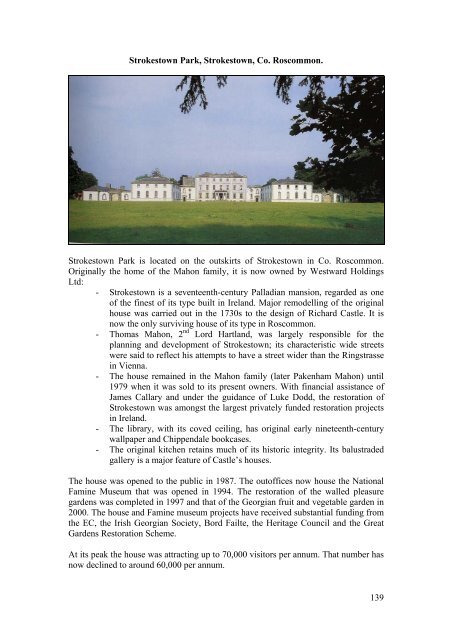A Future for Irish Historic Houses - Irish Heritage Trust
A Future for Irish Historic Houses - Irish Heritage Trust
A Future for Irish Historic Houses - Irish Heritage Trust
You also want an ePaper? Increase the reach of your titles
YUMPU automatically turns print PDFs into web optimized ePapers that Google loves.
Strokestown Park, Strokestown, Co. Roscommon.<br />
Strokestown Park is located on the outskirts of Strokestown in Co. Roscommon.<br />
Originally the home of the Mahon family, it is now owned by Westward Holdings<br />
Ltd:<br />
- Strokestown is a seventeenth-century Palladian mansion, regarded as one<br />
of the finest of its type built in Ireland. Major remodelling of the original<br />
house was carried out in the 1730s to the design of Richard Castle. It is<br />
now the only surviving house of its type in Roscommon.<br />
- Thomas Mahon, 2 nd Lord Hartland, was largely responsible <strong>for</strong> the<br />
planning and development of Strokestown; its characteristic wide streets<br />
were said to reflect his attempts to have a street wider than the Ringstrasse<br />
in Vienna.<br />
- The house remained in the Mahon family (later Pakenham Mahon) until<br />
1979 when it was sold to its present owners. With financial assistance of<br />
James Callary and under the guidance of Luke Dodd, the restoration of<br />
Strokestown was amongst the largest privately funded restoration projects<br />
in Ireland.<br />
- The library, with its coved ceiling, has original early nineteenth-century<br />
wallpaper and Chippendale bookcases.<br />
- The original kitchen retains much of its historic integrity. Its balustraded<br />
gallery is a major feature of Castle’s houses.<br />
The house was opened to the public in 1987. The outoffices now house the National<br />
Famine Museum that was opened in 1994. The restoration of the walled pleasure<br />
gardens was completed in 1997 and that of the Georgian fruit and vegetable garden in<br />
2000. The house and Famine museum projects have received substantial funding from<br />
the EC, the <strong>Irish</strong> Georgian Society, Bord Failte, the <strong>Heritage</strong> Council and the Great<br />
Gardens Restoration Scheme.<br />
At its peak the house was attracting up to 70,000 visitors per annum. That number has<br />
now declined to around 60,000 per annum.<br />
139


